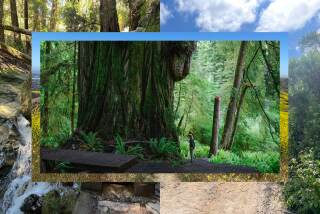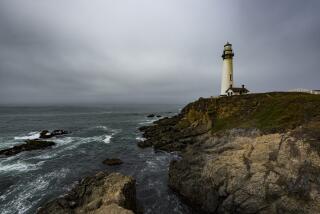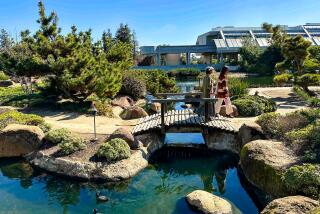Paradise for Hikers With Fins in Virgin Islands
- Share via
Virgin Islands National Park has everything that a Caribbean island should have: white-sand beaches, quiet turquoise lagoons, mangrove swamps and tropical jungle.
For the hiker with an eye for the exotic and thick skin against “no-see-ums”--tiny flying pests common on the East Coast and in the tropics--it’s paradise found.
Virgin Islands National Park was established in 1956, preserving about three-quarters of the island of St. John in the U.S. Virgin Islands. Laurance Rockefeller had quietly accumulated more than 5,000 acres of island land and deeded it to the National Park Service. (In much the same manner, the Rockefellers helped found other national parks, including Grand Teton in Wyoming.)
Largely through Rockefeller’s efforts, St. John escaped becoming a suburb of Atlantic coastal cities like some other islands in the West Indies. What St. John did become is home to one of America’s smallest (9,500 acres) yet most distinct national parks, bringing together an array of cultures and landscapes.
The most popular trail in the park is underwater. At Trunk Bay, novice snorkelers swim face down, reading plaques that have been set on the bottom to mark the trail and identify undersea inhabitants.
Finned humans join damselfish, surgeonfish and a menagerie of other coral fishes such as squirrelfish and parrotfish, to name only a few. Rangers lead guided swims over the elkhorn and brain coral and explain why the superb visibility in these waters may have caused the fish, which rely on color patterns for sexual attraction, to evolve such brilliantly colored scales.
(Bottom sediment stirred up by thousands of swim fins has mucked up the coral along the nature trail, so Trunk Bay cannot be said to offer great diving. However, it’s a good place to learn fundamentals, and, since St. John has 40 more bays, superb snorkeling can be found.)
After exchanging swim fins for hiking shoes, you may be surprised to find that many areas of St. John are quite arid. A community of wind-flattened scrub and barrel cactus grow on the island’s exposed southern and eastern slopes. Lovers of succulents will delight in the commanding century plant, prickly pear and well-named species of barrel cactus known as Turk’s cap.
One of the best walks on the drier side is Ram Head Trail. This hot, two-mile uphill hike passes a salt pond, then climbs to a dramatic viewpoint atop Ram Head cliffs.
On wetter parts of the island, you find a mixture of native and exotic species with intriguing local names such as clashie melashie, elephant tree, bellyache balsam, better man better and jumbie cutlash. This subtropical forest is extremely diverse--2O to 30 full-size species per acre.
The forest plants are as colorful as those found undersea and can best be seen along the three-mile-long Reef Bay Trail. Park naturalists, usually St. John natives, lead hikes along this trail.
Reef Bay Trail leads under some still-stately-but-overgrown rum trees, whose leaves yield an aromatic essence used to season stews and make perfumes and, of course, bay rum. The harvesting of the leaves employed a few native families until the 1930s. Today, however, that quart of duty-free St. John Bay Rum you buy was distilled from imported bay oil.
The trail ends at Reef Bay, once the site of a sugar cane processing factory. Dozens of sugar cane ruins remain today.
You could spend a pleasant week exploring the park’s land and undersea nature trails. Rangers can advise you of trail conditions and direct you to historic sites, petroglyphs and secluded beaches.
If the Rockresort at Caneel Bay (prices for two begin at $275 per night, modified American plan; P.O. Box 720, Cruz Bay 00831-0720, 800-223-7637) is beyond your budget, there are two “campground resorts” on St. John. At the national park’s Cinnamon Bay Campground (Box 720, USVI 00830, 809-776-6330) you can pitch a tent for $12 a night or rent a cottage for $40.
My favorite hideaway, Maho Bay Camp Resort ($45 a night; P.O. Box 310, Cruz Bay 00830, 809-776-6226) is a hillside community of tents, each set on a plank deck and screened from each other and the world by thick forest. The effect for campers is rather like living in a tree house.
For those who “collect” national parks, the way some people collect etchings or jade, Virgin Islands National Park is a rare treasure indeed.
HIKING / St. John, U.S. Virgin Islands
Ram Head, Reef Bay Trails
* Where: Virgin Islands National Park
* Length: 1-6 miles round trip * Terrain: Moist and dry subtropical forest, mangrove swamp * Highlights: White-sand beaches, coral reefs, exotic flora * Degree of Difficulty: Moderate * Precautions: Heat, humidity, bugs * For More Information: Contact the U.S. Virgin Islands Division of Tourism, 3460 Wilshire Blvd., Suite 412, Los Angeles, 90010, (213) 739-0138.
More to Read
Sign up for The Wild
We’ll help you find the best places to hike, bike and run, as well as the perfect silent spots for meditation and yoga.
You may occasionally receive promotional content from the Los Angeles Times.






